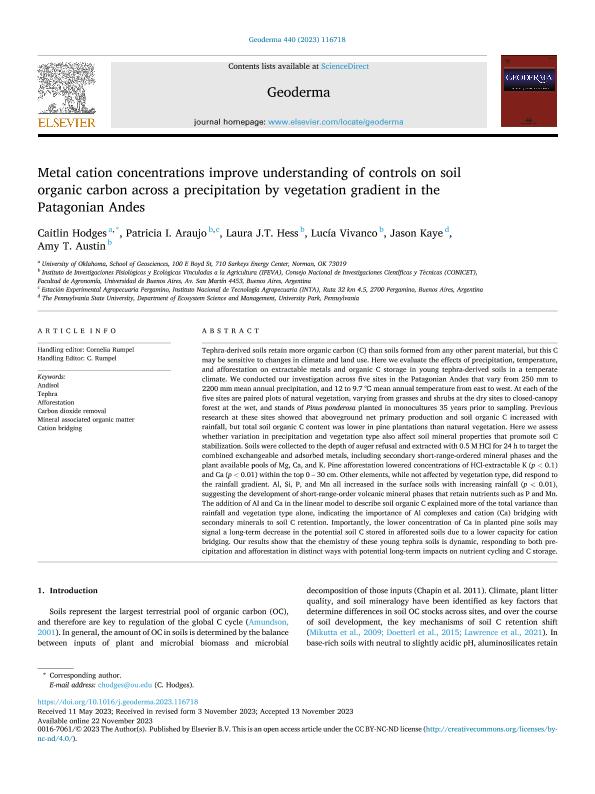Artículo
Metal cation concentrations improve understanding of controls on soil organic carbon across a precipitation by vegetation gradient in the Patagonian Andes
Hodges, Caitlin; Araujo, Patricia Inés ; Hess, Laura J. T.; Vivanco, Lucía
; Hess, Laura J. T.; Vivanco, Lucía ; Kaye, Jason; Austin, Amy Theresa
; Kaye, Jason; Austin, Amy Theresa
 ; Hess, Laura J. T.; Vivanco, Lucía
; Hess, Laura J. T.; Vivanco, Lucía ; Kaye, Jason; Austin, Amy Theresa
; Kaye, Jason; Austin, Amy Theresa
Fecha de publicación:
12/2023
Editorial:
Elsevier Science
Revista:
Geoderma
ISSN:
0016-7061
Idioma:
Inglés
Tipo de recurso:
Artículo publicado
Clasificación temática:
Resumen
Tephra-derived soils retain more organic carbon (C) than soils formed from any other parent material, but this C may be sensitive to changes in climate and land use. Here we evaluate the effects of precipitation, temperature, and afforestation on extractable metals and organic C storage in young tephra-derived soils in a temperate climate. We conducted our investigation across five sites in the Patagonian Andes that vary from 250 mm to 2200 mm mean annual precipitation, and 12 to 9.7 ℃ mean annual temperature from east to west. At each of the five sites are paired plots of natural vegetation, varying from grasses and shrubs at the dry sites to closed-canopy forest at the wet, and stands of Pinus ponderosa planted in monocultures 35 years prior to sampling. Previous research at these sites showed that aboveground net primary production and soil organic C increased with rainfall, but total soil organic C content was lower in pine plantations than natural vegetation. Here we assess whether variation in precipitation and vegetation type also affect soil mineral properties that promote soil C stabilization. Soils were collected to the depth of auger refusal and extracted with 0.5 M HCl for 24 h to target the combined exchangeable and adsorbed metals, including secondary short-range-ordered mineral phases and the plant available pools of Mg, Ca, and K. Pine afforestation lowered concentrations of HCl-extractable K (p < 0.1) and Ca (p < 0.01) within the top 0 – 30 cm. Other elements, while not affected by vegetation type, did respond to the rainfall gradient. Al, Si, P, and Mn all increased in the surface soils with increasing rainfall (p < 0.01), suggesting the development of short-range-order volcanic mineral phases that retain nutrients such as P and Mn. The addition of Al and Ca in the linear model to describe soil organic C explained more of the total variance than rainfall and vegetation type alone, indicating the importance of Al complexes and cation (Ca) bridging with secondary minerals to soil C retention. Importantly, the lower concentration of Ca in planted pine soils may signal a long-term decrease in the potential soil C stored in afforested soils due to a lower capacity for cation bridging. Our results show that the chemistry of these young tephra soils is dynamic, responding to both precipitation and afforestation in distinct ways with potential long-term impacts on nutrient cycling and C storage.
Archivos asociados
Licencia
Identificadores
Colecciones
Articulos(SEDE CENTRAL)
Articulos de SEDE CENTRAL
Articulos de SEDE CENTRAL
Citación
Hodges, Caitlin; Araujo, Patricia Inés; Hess, Laura J. T.; Vivanco, Lucía; Kaye, Jason; et al.; Metal cation concentrations improve understanding of controls on soil organic carbon across a precipitation by vegetation gradient in the Patagonian Andes; Elsevier Science; Geoderma; 440; 12-2023; 1-10
Compartir
Altmétricas



